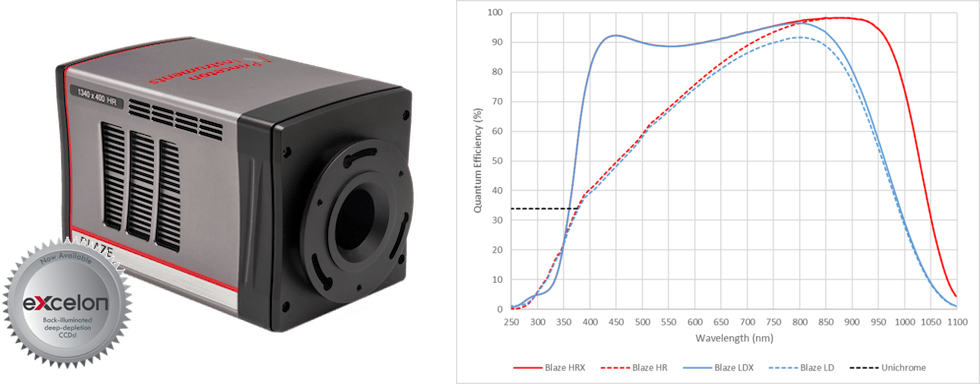Improved BLAZE® Spectroscopy CCD Camera Wavelength Coverage
June 18, 2020
Teledyne Princeton Instruments, the leading developer and manufacturer of advanced scientific cameras and spectroscopy equipment, is pleased to introduce a significant improvement in the performance and wavelength coverage of the BLAZE® spectroscopy CCD camera with eXcelonTM technology. The new BLAZE HRX and LDX camera models offer a no compromise solution to spectroscopic imaging.
To meet the demand of cutting-edge scientific research, Teledyne Princeton Instruments’ BLAZE CCD cameras now have >90% quantum efficiency at 450 nm, 98% at 900 nm and 75% at 1000 nm at -95oC, all while maintaining high frame rates and low dark current. For broad wavelength coverage (190 – 1100 nm) the BLAZE also comes with Unichrome coating.

Improvements are attributed to the addition of eXcelonTM technology to both HR and LD BLAZE sensors, providing highly sensitive spectroscopic imaging coverage across a broad spectrum. With dual port, high readout speeds of 16 MHz and ultra-low noise the improved BLAZE spectroscopic cameras are ideal for applications such as pump probe experiments, new materials research, Raman spectroscopy, and small animal imaging.
All BLAZE camera models continue to be supported by Teledyne Princeton Instruments’ renowned 64-bit LightField® imaging and spectroscopy software. LightField provides multiple user enhancements, including a powerful built-in math engine to perform live data analysis. LightField also supports LabVIEW®, MATLAB®, and Python scripting for easy integration into complex experiments.
The improved BLAZE CCD HRX and LDX cameras are now available. Please contact Teledyne Princeton Instruments or your local representative to learn more.
LabVIEW is a registered trademark of National Instruments. MATLAB is a registered trademark of MathWorks. BLAZE and LightField are registered trademarks of Teledyne Princeton Instruments, alongside the eXcelon trademark.
